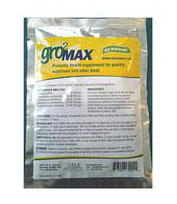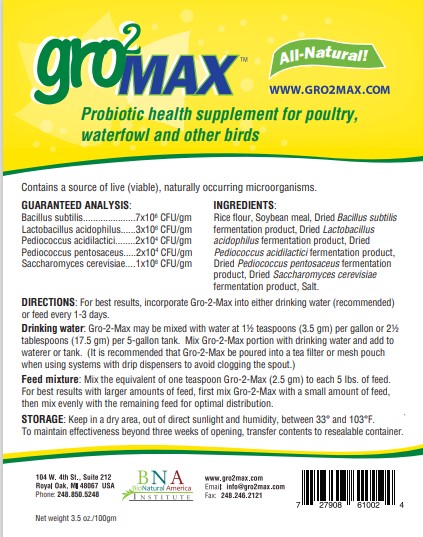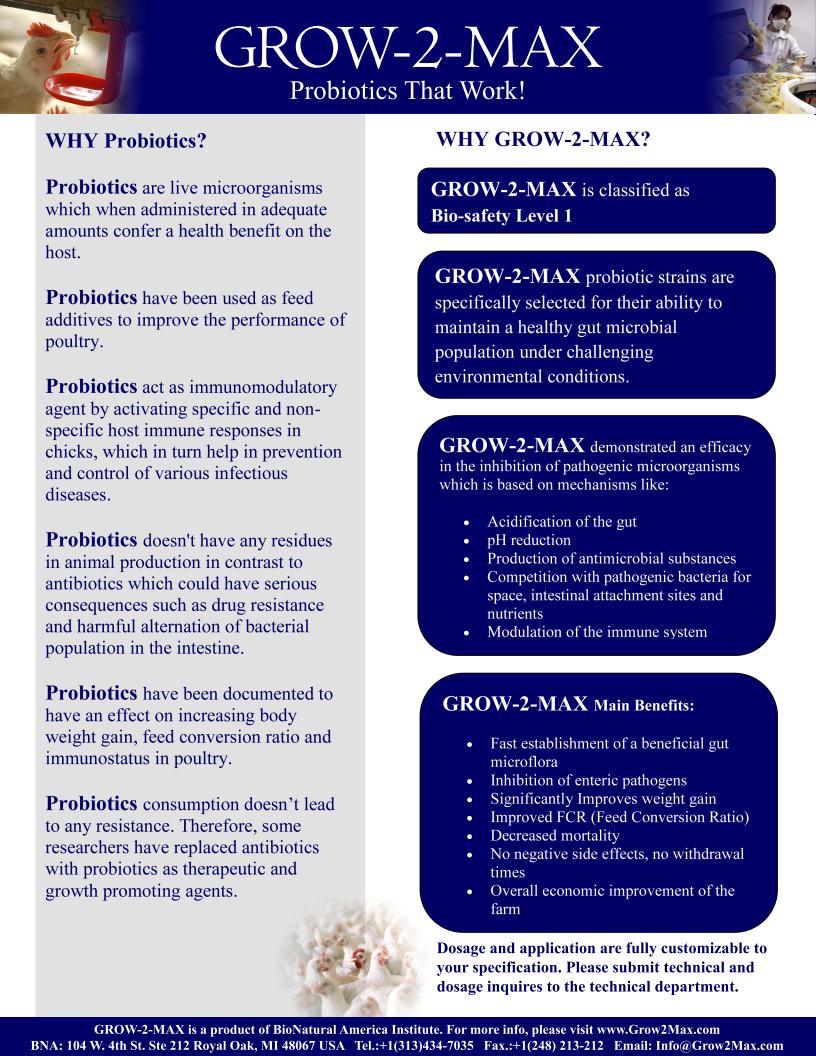Modes of action of GRO2Maxin poultry
Different modes of action of GRO2MAX, which beneficially affect the treated chicks, were discussed. Some of the proposed modes of action of probiotics in poultry include:
1- Maintaining normal micro-flora and beneficial microbial population in the alimentary tract through antagonism and competitive exclusion
2- Rapidly Degrade & Fully Digest Organic Matter) improving feed intake FCR and digestion )through Bacillus amyloliquefaciens which produce enzymes (Amylase, Lipase, Protease, Peptidase, Sucrase) break organic matter into smaller molecules:
3- Toxin Neutralization through Pichia farinosa which creates Toxins Killer to inhibit the growth of yeasts and neutralizes a wide range of toxins
4- Anti-Microbial effect: Antagonistic activity
The antagonistic activity of lactic acid bacteria against different pathogenic microorganisms can be related to the production of bacterial substances as bacteriocins, organic acids, and hydrogen peroxides. Bacteriocins are defined as compounds produced by bacteria, which have a biologically active protein moiety and a bactericidal action.
5- Antifungal effect: Iturins (Antifungal substance) is produced by Bacillus amyloliquefaciens
Functions of each component in GROW 2 MAX
- Pediococcus acidilactici is lactic acid bacteria acts as homofermentator which digests organic matter to mainly lactic acid and a few carbon dioxide, in the mean time generates bacteriocin (antimicrobial agent) named Pediocins. They kill many species of pathogens which are harmful to human and animals i.e.: Salmonella, Echerlichia coli, Pseudomonas, Vibrio cholerae (gram negative bacteria) and Clostridium botulinum, Clostridium perfiengens, Staphylococcus aureus, Listeria monocytogens. etc. (gram positive bacteria)
- Pediococcus pentosaceus is lactic acid bacteria acts as homofermentator which digests organic matter to mainly lactic acid, in the mean time generates bacteriocin (antimicrobial agent) named Pediocins. They kill many species of pathogens which are harmful to human and animals i.e.: Salmonella, E. coli, Pseudomonas, Vibrio cholerae (gram negative bacteria) and Clostridium botulinum, Clostridium perfiengens, Staphylococcus aureus, Listeria monocytogens,etc. (gram positive bacteria)
- Bacillus amyloliquefaciens is bacteria which produces Iturins (Antifungal Agent) and produces many enzymes such as Lipase, Amylase, Protease, Peptidase and Sucrase
- Pichia farinosa is rarely found in the nature. This yeast produces Toxins Killer (Normally, only 5 species of more than 10,000 species that can produce Toxins Killer). They denature many toxins produced from bacteria and fungi such as Aflatoxins, Mycotoxins and Endotoxins.
- Dekkera anomala is called Spoiling Beer Yeast which ferments starch and sugar to acetic acid without alcohol. This yeast also produces many enzymes such as Cellulase, Hemicellulase, Xylanase, Cellubioase, Amylase, Pectinase, Lignase and Arabinase.
Why Grow to Max:
- Pure cultures are kept in secure bio-resource centers in USA
- 11 microbes (bacteria & yeast) are the core ingredients
- classified as Bio-safety Level 1
- Effective in wide range of conditions
- In a multi-stage culturing and fermentation process, under tightly controlled conditions, the pure grow 2 max™ culture is created
- 6 of the 11 microbes are fully metabolised in the production process
- Vacuum freeze drying places the culture into a dry live cell state
- The Live Cell Powder reactivates within minutes in the presence of moisture
Benefits:
- Help your chicks to grow normally and increase their weight by average 10%
- Increase chick immunity making protection against various infectious disease.
- Can shorten your growth cycle, decrease mortality ratio and reduce feeding amounts.
- Accepted as an alternative to in-feed antibiotics in poultry production
- reduce the concentration of ammonia in the excreta and litter of broilers
- Enterotoxin neutralization
- Stimulation of immune system
- highly effective for the control of Salmonellae
How to Apply:
In Feed factories:
We should apply GRO2MAX in Cooling stage after heating to avoid exposing the live organisms to high temperature during spraying of oils, methionine and vitamins . (get drawings from Internet)
Dose: Put 500 gm for each MT of feed
PRE-ACTIVATION:
Equipment
1 x 100 Liters Clean Tank
2 x Fish Tank Air Pumps (recommended that each is to be equipped with 2-Air Outlets).
1 x Fish Tank Cleaning Motors (Filters are to be completely removed).
1 x Temperature Gauge.
1 x pH Gauge.
Procedures
Install the Fish Tank Cleaning Motor at the bottom of the tank (make sure the filters are completely removed).
Install the outlets of one of the Fish Tank Air Pumps at the bottom of the Water Tank.
Fill the Water Tank with 100 Liters of Standard Tap Water.
Keep the Fish Tank Cleaning Motors and the Fish Tank Air Pumps running for 120-minutes before applying the doze.
After 2-hours of continuous aeration to the water; a dose of 1000grams is to be applied for every 100 Liters of Water.
Once the doze has been applied; the second Fish Tank Air Pump is to be applied to the tank.
After starting the 4th hour of the application of the product into the water; the pH value and the Temperature are monitored every hour.
Once the temperature starts rising above 30 degrees celsius; this is an indication that the solution is starting to reach the maturity time and thus both the pH and the temperature are to be monitored every 30-minutes and not every hour and the later applied Air Pump is to be stopped and only the pump at the bottom is to be kept running with the cleaning motor.
Once the pH value starts moving below 7 and/or the solution temperature starts reaching towards the 37 degrees celsius this means that the solution is in its prime condition and is to be applied to the media subject of treatment within a maximum of 1-hour and in this case the air pump is to be stopped once any of the above conditions (pH = 6 or temperature = 37 degrees) one of the 2-outlets of the Air Pump is to be removed.
If the solution reaches this condition and is kept unused for more than 2-hours the pH value will rise again which is an indication that some of the bacterial strains has started dying and thus the solution will lose a good portion of its efficiency.
Special Cases
The above referred conditions would usually take anywhere between 12-18 hours for completion of pre-activaiton depending on the quality of the pre-activating water; room temperature; and strength of the Air Pumps being used for aeration.
If in a special case; the pre-activation is required to be completed within a very short duration; 50mL of Glucose is to be added to the solution with the water filling at the beginning stage which will bring down the pre-activation time to be no more than 3-5 hours. However, this application makes the pre-activation procedure very aggressive and if the solution is not used quickly upon reach of the prime point we will lose multiple strains of the bacteria in the solution.
DOSING:
We should add pre-activated solution by dosing pump to control concentration to be 2 PPM in drinking water. This means :
The concentration of pre-activated solution is 1000 gm per 100 liters i.e. 10000 PPM
This means that we should add 1 ml from pre-activated solution for each 5 Liters of drinking water. This means 20 ml for each 100 liters. this means 1 liter for each 5000 liters




